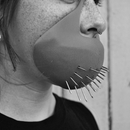Introduction: Project6_learning_CAM
This week's assignment aimed to understand the steps to generate the tool paths required for CNC milling within a CAM software. In this case, we used Fusion 360 Manufacture feature and imported the P9_HaasMill_Aug2017 tool library.
Supplies
Fusion 360
Step 1: Making the Model
I didn't have a previous design that was particularly fitting for this assignment so I modelled a simple planter composed of three parts in Fusion 360. I made sure that each part could fit into the previous part and left one side open in order to insert a piece of glass and see the roots of the growing plant.
I first made a one-piece version of this design but realized after trying to manufacture it that the tools were not long enough to drill a deep hole into the material. I also had to go back and forth from the design to the manufacture process in order to adjust some dimensions that were often to small for the tool at hand, particularly around the glass slit.
Step 2: Manufacture Process
I began by trying to make the three pieces with the same piece of material but quickly abandoned that avenue because each piece was a different height and it was confusing for me to decide which action to do first. So I decided to fabricate each part from a piece of 4'' x 4'' x 1''.
I am not one hundred percent sure that I did this right, but here is the workflow that I followed, inspired by Jennifer Jacobs' instructions.
- facing with a large flat tool.
- 2D adaptive clearing on lower sections of the piece with a flat tool (with a smaller diameter than the previous step)
- 2D pocket with a flat tool (with an even finer diameter than the previous step ~ 1/8'' for my pieces).
- repeating the two previous steps on the contour of the part.
And when drilling was necessary:
- spot drilling at a depth of diameterOfTheHole/2 with a large-ish drill bit.
- drilling a bit further than the full-depth of the hole with a drill bit finer than the actual hole in the design.
- boring the hole with a flat tool that has a finer diameter than the hole.
I took the same strategy with the top and bottom parts of each parts which ended up producing 6 different setups (one for each side on three parts: 2 x 3 = 6).
Watching the simulation generated by Fusion 360, I can see that it is not perfect. I could not match the initial design everywhere on my parts. The slits for the glass, for instance, are not as sharp as they could be. Changing the dimensions or the geometry of the slits could be necessary in order to machine them properly.
Step 3: Rendering
Since we don't have access to a milling machine currently, I rendered my model in Blender. I made an exploded and assembled views of the design.











